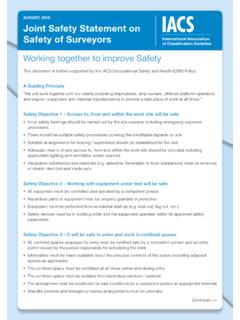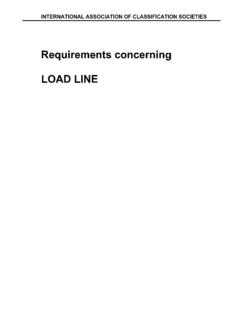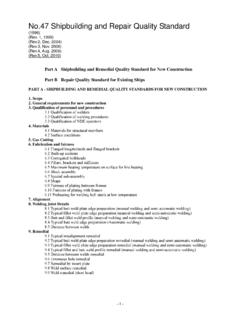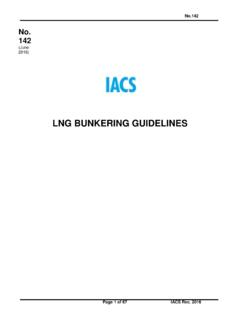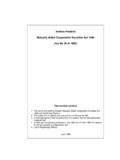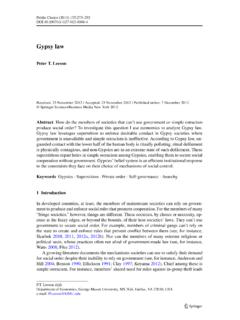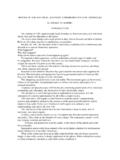Transcription of Classification societies – what, why and how?
1 Classification societies what , why and how?Leading the way: dedicated to safe ships and clean seas, IACS Members make a unique contribution to maritime safety and regulation through technical support, compliance verification and research and development. More than 90% of the world s cargo carrying tonnage is covered by the Classification design, construction and through-life compliance Rules and standards set by the Member societies of societies what , why and how?IACS Information paper2 CONTENTSA INTRODUCTION 3A1 Classification societies today 3 A2 Why Classification ? 3 A3 The International Association of Classification societies IACS 4 B Classification 5B1 Scope of Classification 5B2 Assignment, maintenance, suspension and withdrawal of class 5B3 Classification surveys 6 C DEVELOPMENT OF RULES, REGULATIONS AND GUIDANCE 7C1 Historical development 7 C2 Future development 7 C3 IACS Resolutions 7 C4 Other Publications 8 D SURVEYORS 8 D1 Qualities and qualifications of Surveyors 8 E STATUTORY CERTIFICATION OF SHIPS 8E1 Framework 8 E2 Recognised Organizations 9 APPENDIX 1 THE LANGUAGE OF Classification AND SURVEYS 10 1 Classification societies DEFINITION 102 Classification NOTATIONS 10 Class symbol 10 Construction mark 10 Service notations 10 Navigation and operating area notations 10 Additional class notations 113 ASSIGNMENT, MAINTENANCE.
2 SUSPENSION AND WITHDRAWAL OF CLASS 11 Assignment of class 11 Maintenance of class 11 Suspension of class 11 Withdrawal of class 12 Notification of suspension or withdrawal 12 4 SURVEYS - AN OVERVIEW OF REQUIREMENTS AND CERTIFICATION Definitions and procedures related to Classification surveys 12 Class surveys periodicity and scope 13 Class certificate 14 Definitions and procedures related to statutory surveys and inspections 14 Statutory certificates 15 APPENDIX 2 161 The Members of IACS 16 2 IACS Permanent Secretariat 16 Classification societies what , why and how?IACS Information paper3 Safety of Life at Sea, (SOLAS) and in the 1988 Protocol to the International Convention on Load Lines. This statutory role is addressed later in this note. As an independent, self-regulating, externally audited body, a Classification Society has no commercial interests related to ship design, ship building, ship ownership, ship operation, ship management, ship maintenance or repairs, insurance, or chartering.
3 In establishing its Rules, each Classification Society may draw upon the advice and review of members of the industry and academia who are considered to have relevant knowledge or experience. Classification Rules are developed to establish standards for the structural strength of the ship s hull and its appendages, and the suitability of the propulsion and steering systems, power generation and those other features and auxiliary systems which have been built into the ship to assist in its operation. Classification Rules are not intended as a design code and in fact cannot be used as vessel built in accordance with the applicable Rules of an IACS Member Society may be assigned a class designation by the Society on satisfactory completion of the relevant surveys. For ships in service, the Society carries out surveys to verify that the ship remains in compliance with those Rules. Should any defects that may affect class become apparent, or damages be sustained between the relevant surveys, the owner is required to inform the Society concerned without Classification of a vessel is based on the understanding that the vessel is loaded, operated and maintained in a proper manner by competent and qualified crew or operating vessel may be maintained in class provided that, in the opinion of the Society concerned, it remains in compliance with the relevant Rules, as ascertained by periodic or non-periodic developing its Rules, a Classification Society typically relies on empirical experience gained from classing a wide variety of ship types over many years, coupled with appropriate research that contributes towards the on-going development of relevant, advanced technical societies are often simply referred to as Class societies or just Class ( class ).
4 A2 Why Classification ?In the second half of the 18th century, marine insurers, based at Lloyd s coffee house in London, developed a system for the independent technical assessment of the ships presented to them for insurance cover. In 1760 A INTRODUCTION A1 Classification societies todayThe purpose of a Classification Society is to provide Classification and statutory services and assistance to the maritime industry and regulatory bodies as regards maritime safety and pollution prevention, based on the accumulation of maritime knowledge and objective of ship Classification is to verify the structural strength and integrity of essential parts of the ship s hull and its appendages, and the reliability and function of the propulsion and steering systems, power generation and those other features and auxiliary systems which have been built into the ship in order to maintain essential services on board.
5 Classification societies aim to achieve this objective through the development and application of their own Rules and by verifying compliance with international and/or national statutory regulations on behalf of flag vast majority of commercial ships are built to and surveyed for compliance with the standards laid down by Classification societies . These standards are issued by the Society as published Rules. A vessel that has been designed and built to the appropriate Rules of a Society may apply for a certificate of Classification from that , such a certificate does not imply, and should not be construed as, a warranty of safety, fitness for purpose or seaworthiness of the ship. It is an attestation only that the vessel is in compliance with the Rules that have been developed and published by the Society issuing the Classification certificate. Further, Classification societies are not guarantors of safety of life or property at sea or the seaworthiness of a vessel because the Classification Society has no control over how a vessel is manned, operated and maintained between the periodical surveys which it than 50 organizations worldwide define their activities as providing some form of marine Classification services; however, not all meet the definition given in Appendix 1.
6 Some that do (listed in Appendix 2) form the International Association of Classification societies (IACS). It is estimated that the Members of IACS collectively class over 90 percent of all commercial tonnage involved in international trade is one element within the maritime safety regime. Others with a responsibility for or interest in promoting maritime safety include shipowners, shipbuilders, flag State administrations, port State control authorities, underwriters, shipping financiers, charterers, and, of course, role of Classification and Classification societies has been recognized in the International Convention for the Classification societies what , why and how?IACS Information paper4As the Classification profession evolved, the practice of assigning different classifications has been superseded, with some exceptions. Today a vessel either meets the relevant Class Society s Rules or it does not.
7 As a consequence it is either in or out of class . However, each of the Classification societies has developed a series of notations that may be granted to a vessel to indicate that it is in compliance with some additional voluntary criteria that may be either specific to that vessel type or that are in excess of the standard Classification The International Association of Classification societies - IACSIACS can trace its origins back to the International Load Line Convention of 1930 and its recommendations. The Convention recommended collaboration between Classification societies to secure as much uniformity as possible in the application of the standards of strength upon which freeboard is . Following the Convention, RINA hosted the first conference of major societies in 1939 - also attended by ABS, BV, DNV, GL, LR and NK - which agreed on further cooperation between the societies . A second major Class Society conference, held in 1955, led to the creation of Working Parties on specific topics and, in 1968, to the formation of IACS by seven leading societies .
8 The value of their combined level of technical knowledge and experience was quickly recognised. In 1969, IACS was given consultative status with the International Maritime Organization (IMO). It remains the only non-governmental organization with Observer status which is able to develop and apply Rules. Compliance with the IACS Quality System Certification Scheme (QSCS) is mandatory for IACS Membership. Full details of the scheme are available on the IACS is governed by a Council, with each Member represented by a senior management the Council is the General Policy Group (GPG), made up of a senior manager from each Member, which develops and implements actions giving effect to the policies, directions and long term plans of the chair of GPG is taken by the Member holding the Council chair. IACS s technical work is undertaken generally through specialist Working Groups overseen by Association maintains a Secretariat in London and a QSCS Operations Centre in Southampton, IACS Charter, Procedures, details of the work programme, technical Resolutions and other publications are all available on the IACS website.
9 A Committee was formed for this purpose, the earliest existing result of their initiative being Lloyd s Register Book for the years that time, an attempt was made to classify the condition of each ship on an annual basis. The condition of the hull was classified A, E, I, O or U, according to the excellence of its construction and its adjudged continuing soundness (or otherwise). Equipment was G, M, or B: simply, good, middling or bad. In time, G, M and B were replaced by 1, 2 or 3, which is the origin of the well-known expression A1 , meaning first or highest class .The concept of Classification slowly spread to other countries and insurance markets. Bureau Veritas (BV) was founded in Antwerp in 1828, moving to Paris in 1832. Lloyd s Register of British and Foreign Shipping was reconstituted as a self-standing Classification Society in 1834; Rules for construction and survey were published the same (previously Registro Italiano Navale) dates from 1861; American Bureau of Shipping (ABS) traces its origins back to 1862.
10 Adoption of common Rules for ship construction by Norwegian insurance societies in the late 1850s led to the establishment of Det Norske Veritas (DNV) in 1864. Germanischer Lloyd (GL) was formed in 1867 and Nippon Kaiji Kyokai (ClassNK) in 1899. The Russian Maritime Register of Shipping (RS) was an early offshoot of the River Register of 1913. More recent foundations have been Polish Register of Shipping (PRS) in 1936; Yugoslav Register of Shipping (now the Croatian Register of Shipping (CRS)), 1949; China Classification Society (CCS), 1956; Korean Register of Shipping (KR), 1960; and Indian Register of Shipping (IRS), 1975. Classification societies what , why and how?IACS Information paper5operational elements. Activities which generally fall outside the scope of Classification include such items as: design and manufacturing processes; choice of type and power of machinery and certain equipment ( winches); number and qualification of crew or operating personnel; form and cargo carrying capacity of the ship and manoeuvring performance; hull vibrations; spare parts; life-saving appliances and maintenance equipment.



